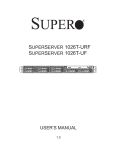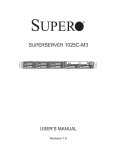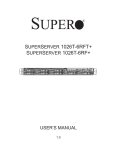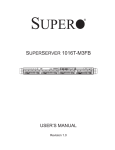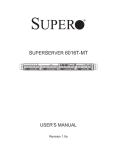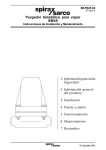Download SUPERSERVER 1026T-M3
Transcript
SUPER
®
SUPERSERVER 1026T-M3
USER’S MANUAL
Revision 1.0
The information in this User’s Manual has been carefully reviewed and is believed to be accurate.
The vendor assumes no responsibility for any inaccuracies that may be contained in this document,
makes no commitment to update or to keep current the information in this manual, or to notify any
person or organization of the updates. Please Note: For the most up-to-date version of this
manual, please see our web site at www.supermicro.com.
Super Micro Computer, Inc. ("Supermicro") reserves the right to make changes to the product
described in this manual at any time and without notice. This product, including software, if any,
and documentation may not, in whole or in part, be copied, photocopied, reproduced, translated or
reduced to any medium or machine without prior written consent.
IN NO EVENT WILL SUPERMICRO BE LIABLE FOR DIRECT, INDIRECT, SPECIAL, INCIDENTAL,
SPECULATIVE OR CONSEQUENTIAL DAMAGES ARISING FROM THE USE OR INABILITY TO
USE THIS PRODUCT OR DOCUMENTATION, EVEN IF ADVISED OF THE POSSIBILITY OF
SUCH DAMAGES. IN PARTICULAR, SUPERMICRO SHALL NOT HAVE LIABILITY FOR ANY
HARDWARE, SOFTWARE, OR DATA STORED OR USED WITH THE PRODUCT, INCLUDING THE
COSTS OF REPAIRING, REPLACING, INTEGRATING, INSTALLING OR RECOVERING SUCH
HARDWARE, SOFTWARE, OR DATA.
Any disputes arising between manufacturer and customer shall be governed by the laws of Santa
Clara County in the State of California, USA. The State of California, County of Santa Clara shall
be the exclusive venue for the resolution of any such disputes. Super Micro's total liability for
all claims will not exceed the price paid for the hardware product.
FCC Statement: This equipment has been tested and found to comply with the limits for a Class
A digital device pursuant to Part 15 of the FCC Rules. These limits are designed to provide
reasonable protection against harmful interference when the equipment is operated in a commercial
environment. This equipment generates, uses, and can radiate radio frequency energy and, if not
installed and used in accordance with the manufacturer’s instruction manual, may cause harmful
interference with radio communications. Operation of this equipment in a residential area is likely
to cause harmful interference, in which case you will be required to correct the interference at your
own expense.
California Best Management Practices Regulations for Perchlorate Materials: This Perchlorate
warning applies only to products containing CR (Manganese Dioxide) Lithium coin cells. “Perchlorate
Material-special handling may apply. See www.dtsc.ca.gov/hazardouswaste/perchlorate”
WARNING: Handling of lead solder materials used in this
product may expose you to lead, a chemical known to
the State of California to cause birth defects and other
reproductive harm.
Manual Revision 1.0
Release Date: July 30, 2009
Unless you request and receive written permission from Super Micro Computer, Inc., you may not
copy any part of this document.
Information in this document is subject to change without notice. Other products and companies
referred to herein are trademarks or registered trademarks of their respective companies or mark
holders.
Copyright © 2009 by Super Micro Computer, Inc.
All rights reserved.
Printed in the United States of America
Preface
Preface
About This Manual
This manual is written for professional system integrators and PC technicians. It
provides information for the installation and use of the SuperServer 1026T-M3. Installation and maintenance should be performed by experienced technicians only.
The SuperServer 1026T-M3 is a 1U rackmount server based on the SC113MTQ560C server chassis and the Super X8DTL-3 serverboard. Please refer to our web
site for updates on supported processors.
Manual Organization
Chapter 1: Introduction
The first chapter provides a checklist of the main components included with the
server system and describes the main features of the Super X8DTL-3 serverboard
and the SC113MTQ-560C chassis.
Chapter 2: Server Installation
This chapter describes the steps necessary to install the SuperServer 1026T-M3 into
a rack and check out the server configuration prior to powering up the system. If your
server was ordered without the processor and memory components, this chapter will
refer you to the appropriate sections of the manual for their installation.
Chapter 3: System Interface
Refer to this chapter for details on the system interface, which includes the functions
and information provided by the control panel on the chassis as well as other LEDs
located throughout the system.
iii
SUPERSERVER 1026T-M3 User's Manual
Chapter 4: System Safety
You should thoroughly familiarize yourself with this chapter for a general overview
of safety precautions that should be followed when installing and servicing the
SuperServer 1026T-M3.
Chapter 5: Advanced Serverboard Setup
Chapter 5 provides detailed information on the X8DTL-3 serverboard, including the
locations and functions of connectors, headers and jumpers. Refer to this chapter
when adding or removing processors or main memory and when reconfiguring the
serverboard.
Chapter 6: Advanced Chassis Setup
Refer to Chapter 6 for detailed information on the SC113MTQ-560C chassis. You
should follow the procedures given in this chapter when installing, removing or
reconfiguring Serial ATA or peripheral drives and when replacing system power
supply units and cooling fans.
Chapter 7: BIOS
The BIOS chapter includes an introduction to BIOS and provides detailed information on running the CMOS Setup Utility.
Appendix A: BIOS POST Error Codes
Appendix B: Installing Windows
Appendix C: System Specifications
iv
Preface
Notes
v
SUPERSERVER 1026T-M3 User's Manual
Table of Contents
Chapter 1 Introduction
1-1
Overview ......................................................................................................... 1-1
1-2
Serverboard Features ..................................................................................... 1-2
Processor ........................................................................................................ 1-2
Memory ........................................................................................................... 1-2
Onboard SAS .................................................................................................. 1-2
Serial ATA ....................................................................................................... 1-2
PCI Expansion Slots ....................................................................................... 1-2
Backpanel Ports .............................................................................................. 1-3
1-3
Server Chassis Features ................................................................................ 1-4
System Power ................................................................................................. 1-4
SAS/SATA Subsystem..................................................................................... 1-4
Control Panel .................................................................................................. 1-4
I/O Backplane.................................................................................................. 1-4
Cooling System ............................................................................................... 1-4
1-4
Contacting Supermicro .................................................................................... 1-5
Chapter 2 Server Installation
2-1
Overview ......................................................................................................... 2-1
2-2
Unpacking the System .................................................................................... 2-1
2-3
Preparing for Setup ......................................................................................... 2-1
Choosing a Setup Location ............................................................................. 2-1
Rack Precautions ............................................................................................ 2-2
Server Precautions.......................................................................................... 2-2
Rack Mounting Considerations ....................................................................... 2-3
Ambient Operating Temperature ................................................................ 2-3
Reduced Airflow ......................................................................................... 2-3
Mechanical Loading ................................................................................... 2-3
Circuit Overloading ..................................................................................... 2-3
Reliable Ground ......................................................................................... 2-3
2-4
Installing the System into a Rack ................................................................... 2-4
Identifying the Sections of the Rack Rails ...................................................... 2-4
Inner Rails ....................................................................................................... 2-5
Outer Rails ...................................................................................................... 2-6
Installing the Server into a Telco Rack ........................................................... 2-9
2-5
Checking the Serverboard Setup .................................................................. 2-10
vi
Table of Contents
2-6
Checking the Drive Bay Setup .......................................................................2-11
Chapter 3 System Interface
3-1
Overview ......................................................................................................... 3-1
3-2
Control Panel Buttons ..................................................................................... 3-1
Reset ............................................................................................................... 3-1
Power .............................................................................................................. 3-1
UID .................................................................................................................. 3-1
3-3
Control Panel LEDs ........................................................................................ 3-2
Universal Information LED .............................................................................. 3-2
NIC2 ................................................................................................................ 3-3
NIC1 ................................................................................................................ 3-3
HDD................................................................................................................. 3-3
Power .............................................................................................................. 3-3
3-4
Drive Carrier LEDs .......................................................................................... 3-4
Chapter 4 System Safety
4-1
Electrical Safety Precautions .......................................................................... 4-1
4-2
General Safety Precautions ............................................................................ 4-2
4-3
ESD Precautions ............................................................................................. 4-3
4-4
Operating Precautions .................................................................................... 4-4
Chapter 5 Advanced Serverboard Setup
5-1
Handling the Serverboard ............................................................................... 5-1
Precautions ..................................................................................................... 5-1
Unpacking ....................................................................................................... 5-2
5-2
Serverboard Installation .................................................................................. 5-2
5-3
Connecting Cables .......................................................................................... 5-3
Connecting Data Cables ................................................................................. 5-3
Connecting Power Cables .............................................................................. 5-3
Connecting the Control Panel ......................................................................... 5-3
5-4
Rear I/O Ports ................................................................................................. 5-4
5-5
Installing the Processor and Heatsink ............................................................ 5-5
Installing an LGA1366 Processor ................................................................... 5-5
Installing a Passive CPU Heatsink ................................................................. 5-7
Removing the Heatsink ................................................................................... 5-8
5-6
Installing Memory Modules ............................................................................. 5-9
Installing & Removing DIMMs ......................................................................... 5-9
Memory Support ....................................................................................... 5-10
Populating DIMMs .................................................................................... 5-10
5-7
Adding PCI Cards ..........................................................................................5-11
vii
SUPERSERVER 1026T-M3 User's Manual
5-8
Serverboard Details ...................................................................................... 5-12
Serverboard Layout ....................................................................................... 5-12
X8DTL-3 Quick Reference ............................................................................ 5-13
5-9
Connector Definitions ................................................................................... 5-14
ATX Power Connector .............................................................................. 5-14
Processor Power Connector ................................................................... 5-14
PW_ON Connector ................................................................................... 5-14
Reset Connector ...................................................................................... 5-14
Power Fail LED ........................................................................................ 5-15
Overheat LED (OH) .................................................................................. 5-15
NIC2 (LAN2) LED ..................................................................................... 5-15
NIC1 (LAN1) LED ..................................................................................... 5-15
HDD LED.................................................................................................. 5-15
Power On LED ......................................................................................... 5-16
NMI Button ............................................................................................... 5-16
Fan Headers............................................................................................. 5-16
ATX PS/2 Keyboard and PS/2 Mouse Ports ............................................ 5-16
Chassis Intrusion ...................................................................................... 5-16
Universal Serial Bus (USB) ...................................................................... 5-17
Serial Ports ............................................................................................... 5-17
Wake-On-LAN .......................................................................................... 5-17
Onboard Speaker (SP1) ........................................................................... 5-18
Power LED/Speaker ................................................................................. 5-18
SGPIO Headers ....................................................................................... 5-18
I-Button ..................................................................................................... 5-18
LAN1/2 (Ethernet Ports) ........................................................................... 5-19
Power SMB (I2C) Header ......................................................................... 5-19
IPMB ......................................................................................................... 5-19
Overheat LED/Fan Fail (JOH1) ................................................................ 5-19
Unit Identifier Button................................................................................. 5-19
5-10
Jumper Settings ............................................................................................ 5-20
Explanation of Jumpers ................................................................................ 5-20
CMOS Clear ............................................................................................. 5-20
VGA Enable/Disable ................................................................................. 5-20
LAN1/LAN2 Enable/Disable ..................................................................... 5-21
Watch Dog ................................................................................................ 5-21
SAS Enable/Disable ................................................................................. 5-21
SAS RAID Mode Select ........................................................................... 5-21
I2C Bus to PCI/PCI-Exp. Slots ................................................................. 5-22
viii
Table of Contents
5-11
Onboard Indicators........................................................................................ 5-22
LAN1/LAN2 LEDs ..................................................................................... 5-22
Onboard Power LED ............................................................................... 5-22
SAS Heartbeat LED (X8DTL-3/-3F) ......................................................... 5-22
Rear UID LED ......................................................................................... 5-23
5-12
SAS and SATA Ports..................................................................................... 5-23
SAS Ports ................................................................................................. 5-23
SATA Ports ............................................................................................... 5-23
5-13
Installing Software ......................................................................................... 5-24
Supero Doctor III ........................................................................................... 5-25
Chapter 6 Advanced Chassis Setup
6-1
Static-Sensitive Devices .................................................................................. 6-1
Precautions ..................................................................................................... 6-1
6-2
Control Panel .................................................................................................. 6-2
6-3
System Cooling ............................................................................................... 6-2
System Fan Failure ......................................................................................... 6-3
6-4
Drive Bay Installation/Removal ....................................................................... 6-4
Accessing the Drive Bays ............................................................................... 6-4
Hard Drive Installation..................................................................................... 6-4
DVD Drive Installation ..................................................................................... 6-6
6-5
Power Supply .................................................................................................. 6-7
Power Supply Failure ...................................................................................... 6-7
Chapter 7 BIOS
7-1
Introduction...................................................................................................... 7-1
Starting BIOS Setup Utility .............................................................................. 7-1
How To Change the Configuration Data ......................................................... 7-1
Starting the Setup Utility ................................................................................. 7-2
7-2
Main Setup ...................................................................................................... 7-2
7-3
Advanced Setup Configurations...................................................................... 7-4
7-4
Security Settings ........................................................................................... 7-23
7-5
Boot Configuration ........................................................................................ 7-24
7-6
Exit Options ................................................................................................... 7-26
Appendix A BIOS Post Error Codes
Appendix B Installing Windows
Appendix C System Specifications
ix
SUPERSERVER 1026T-M3 User's Manual
Notes
x
Chapter 1: Introduction
Chapter 1
Introduction
1-1
Overview
The Supermicro SuperServer 1026T-M3 is a short-depth, 1U rackmount server
comprised of two main subsystems: the SC113MTQ-560C chassis and the X8DTL-3
serverboard. Please refer to our web site for information on operating systems that
have been certified for use with the 1026T-M3.
In addition to the mainboard and chassis, various hardware components may have
been included with the 1026T-M3, as listed below.
•
Two passive CPU heatsinks (SNK-P0037P)
•
One DVD-ROM drive (DVM-TEAC-824B)
•
One mini IDE to SATA adapter (CDM-PSATA)
•
Four 4-cm fans (FAN-0065L4)
•
One air shroud (MCP-310-18003-0N)
•
SAS/SATA Accessories:
One internal SAS/SATA backplane (BPN-SAS-113TQ)
One set of SATA cables (CBL-0190L)
One SGPIO cable (CBL-0157L)
One SATA cable (CBL-206L)
Eight SAS/SATA drive carriers (MCP-220-00047-0B)
•
One PCI-E x16 slot riser card (CSE-RR1U-E16)
•
Rackmount hardware with screws (CSE-PT52)
•
One CD containing drivers and utilities
•
SuperServer 1026T-M3 User's Manual
Note: "B" indicates black.
1-1
SUPERSERVER 1026T-M3 User's Manual
1-2
Serverboard Features
The X8DTL-3 is a dual processor serverboard based upon Intel's 5500 + ICH10R
chipset. Below are the main features of the X8DTL-3.
Processor
The X8DTL-3 supports single or dual two Intel® 5500 Series processors in LGA1366
sockets. Please refer to our web site for a complete listing of supported processors
(www.supermicro.com).
Memory
The X8DTL-3 has six 240-pin DIMM slots that can support up to 24 GB of ECC
registered DDR3-1333/1066/800 SDRAM.
Onboard SAS
An onboard LSI 1068E SAS controller in integrated into the X8DTL-3. The hot-swap
SAS drives are connected to a backplane that provides power, bus termination and
configuration settings.
Note: The operating system you use must have RAID support to enable
the hot-swap capability and RAID function of the SAS drives. RAID 0, 1,
5 and 10 are supported. Refer to the following ftp site for setup guidelines
<ftp://ftp.supermicro.com/driver/SAS/LSI/LSI_SAS_EmbMRAID_SWUG.pdf>.
Serial ATA
An on-chip (ICH10R) SATA controller is integrated into the X8DTL-3 to provide a
six-port, 3 Gb/sec SATA subsystem, which is RAID 0, 1, 5 and 10 supported. The
SATA drives are hot-swappable units. For more information on SATA HostRAID
confi guration, please refer to the Intel SATA HostRAID User's Guide posted on our
website at http://www.supermicro.com/support/manuals/.
Note: You must have RAID set up to enable the hot-swap capability of the SATA
drives.
PCI Expansion Slots
The X8DTL-3 has two PCI-Express 2.0 x8 slots, one PCI-Express 2.0 x4 slot, one
PCI-Express x4 slot and two PCI 33 MHz slots. One PCI-Express x8 slot is populated with a riser card (included).
1-2
Chapter 1: Introduction
Backpanel Ports
Onboard I/O backpanel ports include one COM port, a VGA port, two USB ports,
PS/2 mouse and keyboard ports and two Gigabit LAN (NIC) ports. A UID button is
also included on the backpanel.
Other Features
Other onboard features that promote system health include voltage monitors, a
chassis intrusion header, auto-switching voltage regulators, chassis and CPU
overheat sensors, virus protection and BIOS rescue.
Figure 1-1 . Intel 5500 Chipset: System Block Diagram
Port 0 Gen 2 x8
Port 1
Ports 1,2
Ports 9,10
E
Intel 5500
Gen 2 x8
Ports 7,8
ESI
CLINK
Gen 1 x4
ATMEL
AT25DF321
PCI 33 (Slot 2)
SPI
PCI 33 (Slot 1)
F
DDR3 DIMM
LGA1366
DDR3 DIMM
CPU2
LGA1366
Gen 2 x4
DDR3 DIMM
CSI
CPU1
Ports 1-4
Port 5
DMI CLIN
PCI-E x8 (Slot 3)
PCI-E x16 (Slot 6)
D
A
PCI-E x8 (Slot 4)
DDR3 DIMM
B
PCI-E x8 (Slot 5)
C
DDR3 DIMM
DDR3 DIMM
Note: This is a general block diagram. Please see Chapter 5 for details.
x1
82574L
RJ45
82574L
RJ45
PCI 32bit_33MHz
ICH10R
Port 6
SATA
COM1
BMC
COM2
RJ45 VGA CONN
USB
SATA #1
SATA #2
SATA #3
SATA #4
SATA #5
SATA #6
Rear
Front
Front
Type A
x1
LPC
USB0/1
SIO
USB2/3
USB4/5 W83527DHG-P
USB6
PS2 KB/MS
1-3
SUPERSERVER 1026T-M3 User's Manual
1-3
Server Chassis Features
The following is a general outline of the main features of the SC113MTQ-560C
chassis. See Chapter 6 for more details.
System Power
When configured as a SuperServer 1026T-M3, the SC113MTQ-560C chassis includes a single 560W power supply.
SAS/SATA Subsystem
For the 1026T-M3, the SC113MTQ-560C chassis was designed to support eight
SAS or SATA hard drives, which are hot-swappable units.
Note: The operating system you use must have RAID support to enable the hotswap capability of the SAS drives (there is no system support for SATA drives).
Control Panel
The SC113MTQ-560C control panel provides important system monitoring and
control information. LEDs indicate power on, network activity, hard disk drive activity and a UID (Universal Information) LED. Also present are a main power button,
a system reset button and a UID button.
I/O Backplane
The SC113MTQ-560C is a short-depth, 1U rackmount chassis. Its I/O backplane
provides three PCI slots, one COM port (the other is internal), one VGA port, two
USB ports, PS/2 mouse and keyboard ports, two Ethernet (LAN) ports and a UID
LED.
Cooling System
The SC113MTQ-560C chassis' revolutionary cooling design has been optimized to
provide sufficient cooling for dual CPU configurations. The chassis includes four
4-cm PWM (Pulse Width Modulated) fans located in the middle of the system.
There is a "Fan Speed Control Mode" in BIOS that allows chassis fan speed to be
determined by system temperature.
1-4
Chapter 1: Introduction
1-4
Contacting Supermicro
Headquarters
Address:
Super Micro Computer, Inc.
980 Rock Ave.
San Jose, CA 95131 U.S.A.
Tel:
+1 (408) 503-8000
Fax:
+1 (408) 503-8008
Email:
[email protected] (General Information)
[email protected] (Technical Support)
Web Site:
www.supermicro.com
Europe
Address:
Super Micro Computer B.V.
Het Sterrenbeeld 28, 5215 ML
's-Hertogenbosch, The Netherlands
Tel:
+31 (0) 73-6400390
Fax:
+31 (0) 73-6416525
Email:
[email protected] (General Information)
[email protected] (Technical Support)
[email protected] (Customer Support)
Asia-Pacific
Address:
Super Micro Computer, Inc.
4F, No. 232-1, Liancheng Rd.
Chung-Ho 235, Taipei County
Taiwan, R.O.C.
Tel:
+886-(2) 8226-3990
Fax:
+886-(2) 8226-3991
Web Site:
www.supermicro.com.tw
Technical Support:
Email:
[email protected]
Tel:
886-2-8228-1366, ext.132 or 139
1-5
SUPERSERVER 1026T-M3 User's Manual
Notes
1-6
Chapter 2: Server Installation
Chapter 2
Server Installation
2-1
Overview
This chapter provides a quick setup checklist to get your SuperServer 1026T-M3 up
and running. Following these steps in the order given should enable you to have
the system operational within a minimum amount of time. This quick setup assumes
that your 1026T-M3 system has come to you with the processors and memory preinstalled. If your system is not already fully integrated with a serverboard, processors,
system memory etc., please turn to the chapter or section noted in each step for
details on installing specific components.
2-2
Unpacking the System
You should inspect the box the 1026T-M3 was shipped in and note if it was damaged in any way. If the server itself shows damage you should file a damage claim
with the carrier who delivered it.
Decide on a suitable location for the rack unit that will hold the 1026T-M3. It should
be situated in a clean, dust-free area that is well ventilated. Avoid areas where
heat, electrical noise and electromagnetic fields are generated. You will also need
it placed near a grounded power outlet. Read the Rack and Server Precautions in
the next section.
2-3
Preparing for Setup
The box the 1026T-M3 was shipped in should include two sets of rail assemblies,
two rail mounting brackets and the mounting screws you will need to install the
system into the rack. Follow the steps in the order given to complete the installation
process in a minimum amount of time. Please read this section in its entirety before
you begin the installation procedure outlined in the sections that follow.
Choosing a Setup Location
•
Leave enough clearance in front of the rack to enable you to open the front door
completely (~25 inches) and approximately 30 inches of clearance in the back
of the rack to allow for sufficient airflow and ease in servicing.This product is for
installation only in a Restricted Access Location (dedicated equipment rooms,
service closets and the like).
2-1
SUPERSERVER 1026T-M3 Manual
•
This product is not suitable for use with visual display work place devices
acccording to §2 of the the German Ordinance for Work with Visual Display
Units.
!
Warnings and Precautions!
!
Rack Precautions
•
•
Ensure that the leveling jacks on the bottom of the rack are fully extended to
the floor with the full weight of the rack resting on them.
In single rack installation, stabilizers should be attached to the rack. In multiple
rack installations, the racks should be coupled together.
•
Always make sure the rack is stable before extending a component from the
rack.
•
You should extend only one component at a time - extending two or more simultaneously may cause the rack to become unstable.
Server Precautions
•
•
•
Review the electrical and general safety precautions in Chapter 4.
Determine the placement of each component in the rack before you install the
rails.
Install the heaviest server components on the bottom of the rack first, and then
work up.
•
Use a regulating uninterruptible power supply (UPS) to protect the server from
power surges, voltage spikes and to keep your system operating in case of a
power failure.
•
Allow the hot plug SAS/SATA drives and power supply modules to cool before
touching them.
•
Always keep the rack's front door and all panels and components on the servers
closed when not servicing to maintain proper cooling.
2-2
Chapter 2: Server Installation
Rack Mounting Considerations
Ambient Operating Temperature
If installed in a closed or multi-unit rack assembly, the ambient operating temperature of the rack environment may be greater than the ambient temperature of the
room. Therefore, consideration should be given to installing the equipment in an
environment compatible with the manufacturer’s maximum rated ambient temperature (Tmra).
Reduced Airflow
Equipment should be mounted into a rack so that the amount of airflow required
for safe operation is not compromised.
Mechanical Loading
Equipment should be mounted into a rack so that a hazardous condition does not
arise due to uneven mechanical loading.
Circuit Overloading
Consideration should be given to the connection of the equipment to the power
supply circuitry and the effect that any possible overloading of circuits might have
on overcurrent protection and power supply wiring. Appropriate consideration of
equipment nameplate ratings should be used when addressing this concern.
Reliable Ground
A reliable ground must be maintained at all times. To ensure this, the rack itself
should be grounded. Particul










































































































